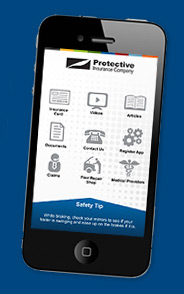| Pay attention! The dangers of distracted driving are real |
| Distracted driving is one of the major causes of motor vehicle collisions today. According to Distraction.gov over 3,000 motorists are killed and another 421,000 are injured each year as a result of distracted driving collisions. It's estimated that distracted driving increases chances of having a collision by up to three times. |
| It's important for you and your drivers to understand the different types of distracted driving exposures as well as the proper skills to avoid said distractions. Download our free handout to remind yourself how to create a distraction-free environment. |
| Manual distractions
|
| These distractions occur when the hands and eyes are moved away from controlling the vehicle like texting or eating and drinking. If a driver looks down for five seconds to read a text message while traveling at 35 mph, he or she will have gone over 250 feet without their eyes on the road! The best practice is for drivers to silence their phones and never have them within reach while driving. The only safe time to look at a device is when you are safely parked and off the roadway. |
| Auditory and visual distractions
|
| These occur when what you see or hear causes you to lose focus on the road, such as loud music, passengers, or reading billboards, signs and directions. Glare from the sun can also affect a driver's vision of the road and vehicles around them. Plan your trip in advance so it is not necessary to refer to maps, GPS or other in-cab distractions. Enjoy your view but stay focused on the view of the road and the vehicles around you. |
| Cognitive distractions
|
| These distractions are the most difficult to recognize and control. They occur when a driver's mind is not focused, such as when they are fatigued, thinking about personal or work issues, battling health issues or talking on the phone. |
| It has been scientifically proven that our brains cannot multitask. The brain can only focus on one task at a time and must constantly switch back and forth. When talking on a cell phone, your brain is so focused on the conversation that you may "see" a hazard but your brain does not recognize it as a hazard, giving you no time to react safely. Hands-free devices do NOT eliminate the cognitive distraction. |
| What can you do?
|
| 1. Develop a formal written policy that strictly prohibits all forms of distracted driving at your company. Ask drivers to Take the Pledge with the U.S. Department of Transportation. |
| 2. Discuss and issue this policy to your drivers and have them acknowledge receipt by signing off. |
| 3. Train your drivers regularly on the dangers of distracted driving, among other safety topics. |
| 4. Observe your drivers, hold them accountable through progressive discipline and provide coaching for improvement. |
| Distracted driving is a serious issue that cannot be taken lightly. For more tips on limiting distractions, download our free handout "Creating a Distraction-Free Zone." |
| Safety roundtables coming to a city near you!
|
| Protective is hosting safety roundtables this month in the cities listed below. You’ll receive hands-on training to help you develop a safety program for your drivers based on the top losses we see annually.
|
| Saturday, April 11 – Orlando, FL
|
| Monday, April 13 – Miami, FL
|
| Saturday, April 18 – Chino Hills, CA |
| Monday, April 20 – Burbank, CA |
| Wednesday, April 22 – San Francisco, CA |
| Thursday, April 23 – Hayward, CA |
| For more information, contact our Loss Prevention Department at lossprevention@protectiveinsurance.com or 800-644-5501 ext. 7341. And look for more dates and locations in the next IC Safety! |
|
| New features available on the Protective mobile app!
|
| The Protective mobile app now makes it easy to view the status of claims, find in-network medical providers and more. Click to download or update for iPhone or Android today! |
|
|
|
|
|
 |
|
| Note: Not all features are available to all customers. Please refer to the app's description in the App Store or Google Play for full details. |
|
